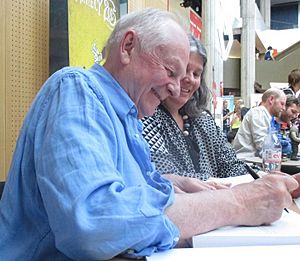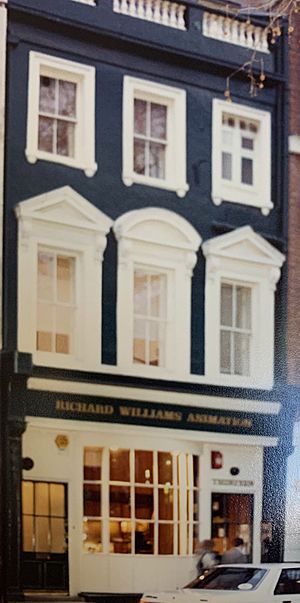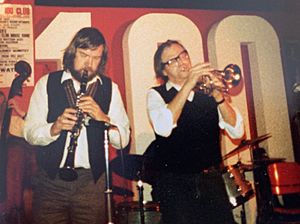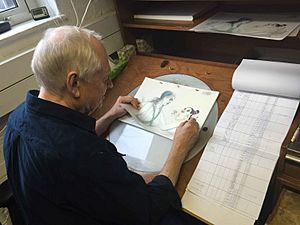Richard Williams (animator) facts for kids
Quick facts for kids
Richard Williams
|
|
|---|---|

Williams signing copies of The Animator's Survival Kit at the Annecy Film Festival in 2015
|
|
| Born |
Richard Edmund Williams
March 19, 1933 |
| Died | August 16, 2019 (aged 86) Bristol, England
|
| Nationality | Canadian, British |
| Education | Northern Secondary School |
| Alma mater | Ontario College of Art Royal College of Art (honourary doctorate) |
| Occupation | Animator, voice actor, director, writer |
| Years active | 1957–2019 |
|
Notable work
|
Who Framed Roger Rabbit The Thief and the Cobbler A Christmas Carol |
| Spouse(s) |
Stephanie Ashforth
(m. 1953; div. 1956)Lois Catherine Steuart
(m. 1966; div. 1976)Margaret French
(m. 1976, divorced)Imogen Sutton |
| Children | 6; including Alexander |
| Awards | 3 Academy Awards (1971, 1988) |
Richard Edmund Williams (born March 19, 1933 – died August 16, 2019) was a talented Canadian-British artist. He was an animator, voice actor, director, and writer. He is most famous for being the animation director for the movie Who Framed Roger Rabbit (1988). For this movie, he won two Academy Awards, also known as Oscars.
Richard Williams was also known for his long-term project, the animated film The Thief and the Cobbler (1993), which he worked on for many years. Besides movies, he designed title sequences for films like What's New Pussycat? (1965) and A Funny Thing Happened on the Way to the Forum (1966). He also created the animated intros for some Pink Panther movies. In 2002, he wrote a very important book called The Animator's Survival Kit, which teaches people how to animate. This book later became a DVD set and an app. From 2008, he worked at Aardman Animations in Bristol. In 2015, his short film Prologue was nominated for both an Oscar and a BAFTA award.
Contents
- Early Life and Animation Dreams
- Career Highlights
- Starting Out: Ibiza, London, and The Little Island
- Building a Studio: Film Titles and Commercials
- Award-Winning Work: A Christmas Carol and The Pink Panther
- Blockbuster Success: Who Framed Roger Rabbit
- The Long Journey of The Thief and the Cobbler
- Later Years: The Animator's Survival Kit and Prologue
- Personal Life
- Death
- Filmography
- Images for kids
- See also
Early Life and Animation Dreams
Richard Williams was born in Toronto, Ontario, Canada. His mother, Kathleen "Kay" Bell, was an illustrator who drew beautiful pictures. His stepfather, Kenneth D C Williams, adopted him.
Richard grew up in Toronto and loved putting on magic and comedy shows with his friend Martin Hunter. His mother's drawings were inspired by famous artists, and she read him stories from the Arabian Nights. These stories later inspired his big project, The Thief and the Cobbler. When he was five, his mother took him to see Snow White and the Seven Dwarfs (1937). This movie made a huge impression on him, and he often said it changed his life.
He went to Northern Secondary School in Toronto. Even then, he was known for sketching his teachers with an animator's touch.
When he was 15, Richard took a long bus trip from Toronto to Hollywood. He visited the Disney studio tour three days in a row, trying to meet the animators. After his mother contacted a friend at Disney, he finally got to meet them. They showed him how Disney animation worked, which was a dream come true for him.
By age 17, Richard was already working as a commercial artist, creating ads. He later studied art at the Ontario College of Art.
Career Highlights
Starting Out: Ibiza, London, and The Little Island
In 1953, Richard saw a painting exhibition that deeply moved him. For a while, he stopped being interested in animation. He moved to Ibiza and became a painter, finding inspiration in circus performers. These sketches later became his short film Circus Drawings (2010). In Ibiza, he also played in a jazz band, a passion he kept throughout his life.
While in Ibiza, he started drawing ideas for an animated film. In 1955, he moved to England and began working on TV commercials. He also started making his own animated short film, The Little Island. He realized his paintings felt like they wanted to move, which drew him back to animation.
In 1958, Richard finished The Little Island. This film launched his career. It told the story of three men on a desert island, each representing truth, beauty, and good. The film won a BAFTA Award for Best Animated Film in 1958.
Building a Studio: Film Titles and Commercials
After the success of his next short film, Love Me, Love Me, Love Me (1962), Richard was able to start his own company, Richard Williams Animation Ltd. His studio, located at 13 Soho Square in London, made over 2,500 TV commercials and won many awards.
In the 1960s, he animated title sequences for several movies, including What's New Pussycat? (1965) and A Funny Thing Happened on the Way to the Forum (1966). In 1968, his studio received praise for the animated parts in the movie The Charge of the Light Brigade.
Around the mid-1960s, Richard began working on a very personal project. He wanted to create "the best animated feature ever." This film was based on the tales of Mulla Nasrudin and was first called Nasrudin. This project later changed and became The Thief and the Cobbler.
Richard Williams brought many famous animators from the 1930s Hollywood era to London. These included legends like Art Babbitt (who animated Goofy) and Grim Natwick (who animated Betty Boop). These experienced animators taught a new generation of artists at his studio.
Award-Winning Work: A Christmas Carol and The Pink Panther
In 1971, Richard Williams directed A Christmas Carol, an animated movie based on Charles Dickens's famous story. The film's look was inspired by the original drawings from 1843. It won an Academy Award for Best Animated Short Film in 1972.
Around 1973, Richard started to change his Nasrudin film idea. It became a new story about a quiet thief who wants to steal three golden balls that protect an ancient city. Richard animated many parts of this film himself, spending years perfecting even small scenes.
He also animated the opening credits for Blake Edwards' Return of the Pink Panther (1975) and The Pink Panther Strikes Again (1976).
Blockbuster Success: Who Framed Roger Rabbit
In 1987, Richard took on his biggest project yet: becoming the animation director for the Disney and Steven Spielberg film Who Framed Roger Rabbit (1988). At first, he didn't want to do it because he didn't like mixing animation with live-action. But Disney and Spielberg promised to help him finish The Thief and the Cobbler if he worked on Roger Rabbit.
Richard designed many characters for the film, including the famous Jessica Rabbit. He worked incredibly hard, often without much sleep, to make sure the animation was perfect and finished on time.
In 1989, after Who Framed Roger Rabbit was a huge success, Richard Williams won two more Academy Awards. He received an award for Best Special Effects and a Special Achievement Award for his amazing animation work.
Outside of animation, Richard loved Dixieland jazz music. He led a band in London called Dix Six, which played regularly at various clubs.
The Long Journey of The Thief and the Cobbler
Richard Williams' most ambitious project was The Thief and the Cobbler. He started working on this hand-animated film, inspired by the Arabian Nights, in 1964. He initially paid for it himself. After more than twenty years, he had only finished about twenty minutes of the film.
After the success of Who Framed Roger Rabbit, Warner Bros. agreed to help finance and distribute The Thief. However, the film took longer than expected. In 1992, with only a small part left to finish, the company that insured the film's funding took over the project. They were worried about competition from Disney's Aladdin.
Other animators then finished the film, adding new scenes and musical parts. This version was released in some countries as The Princess and the Cobbler. Later, another company, Miramax, bought the rights and changed the film even more, adding lots of dialogue and cutting many long sequences. This version was released in North America as Arabian Knight. For a long time, Richard preferred not to talk about what happened to his film.
After this, Richard closed his company and moved back to Canada with his family for five years. To make a living, he started teaching animation masterclasses around the world. In these classes, he shared his animation skills and his talent for performing.
In 1997, Richard moved back to the UK, settling in Bristol, where he lived for the rest of his life.
Later Years: The Animator's Survival Kit and Prologue
The notes from Richard's masterclasses became the basis for his famous book, The Animator's Survival Kit. Published in 2002, this book quickly became a key guide for animators everywhere. It was later released as a DVD set and an iPad app.
From 2008, Richard worked as an artist-in-residence at Aardman Animations in Bristol. He even worked at one of his original Disney animation desks from 1938. Even in his 80s, he continued to work every day, showing his dedication to animation.
In 2010, Richard finished his 9-minute short film called Circus Drawings, which he had started sketching in Ibiza in the 1950s.
In 2015, his short film Prologue was nominated for both an Oscar and a BAFTA award. Prologue was the first six minutes of a longer hand-drawn film he planned called Lysistrata, based on an ancient Greek comedy. Richard often joked about whether he would live to finish it. He described Prologue as the only thing in his career he was truly pleased with. Like The Thief and the Cobbler, his Lysistrata project was never fully completed.
Personal Life
Richard Williams was married four times and had six children. His children include Alexander Williams, Claire Williams, Timothy Williams, Holly Williams, Natasha Sutton-Williams, and Leif Sutton-Williams. Toward the end of his life, he lived in Bristol with his fourth wife, Imogen Sutton.
Death
Richard Williams passed away from cancer on August 16, 2019, at his home in Bristol, England. He continued to create art until the very end of his life.
Filmography
Animated Shorts and Features
- The Little Island (1958) (director, writer, producer, animator)
- Love Me, Love Me, Love Me (1962) (director, producer, animator)
- A Lecture on Man (1962) (director, writer, producer, animator)
- The Apple (1963) (designer, storyboard artist)
- The Dermis Probe (1965) (director, editing, script Idries Shah)
- Sailor and the Devil (1965) (producer)
- A Christmas Carol (TV movie) (1971) (director, producer) (Oscar win)
- Raggedy Ann & Andy: A Musical Adventure (1977) (director, production supervisor, animator)
- Ziggy's Gift (TV movie) (1982) (director, producer, voice of Crooked Santa)
- Who Framed Roger Rabbit (1988) (animation director, voice of Droopy)
- Tummy Trouble (1989) (voice of Droopy)
- The Thief and the Cobbler (1993) (director, screenplay, producer, lead animator, voice of Laughing Brigand)
- Circus Drawings (2010) (director, animator)
- Prologue (2015) (director, animator) (Oscar nomination)
Titles in Live-action Films
- What's New Pussycat? (1965) (titles)
- The Liquidator (1965) (titles)
- A Funny Thing Happened on the Way to the Forum (1966) (title designer)
- The Spy with a Cold Nose (1966) (title designer)
- Casino Royale (1967) (titles, montage effects)
- Sebastian (1968) (titles)
- Here We Go Round the Mulberry Bush (1968) (title designer)
- The Charge of the Light Brigade (1968) (title animation)
- Prudence and the Pill (1968) (titles)
- Can Heironymus Merkin Ever Forget Mercy Humppe and Find True Happiness? (1969) (animation director: title sequence)
- Every Home Should Have One (1970) (titles and animated sequences)
- The Return of the Pink Panther (1975) (title animation)
- The Pink Panther Strikes Again (1976) (title animation)
Images for kids
See also
 In Spanish: Richard Williams para niños
In Spanish: Richard Williams para niños
- Independent animation
- Yuri Norstein - another famous animator who faced challenges with his film The Overcoat
- Paul Grimault - an acclaimed animator who also had difficulties with his film The King and the Mockingbird







